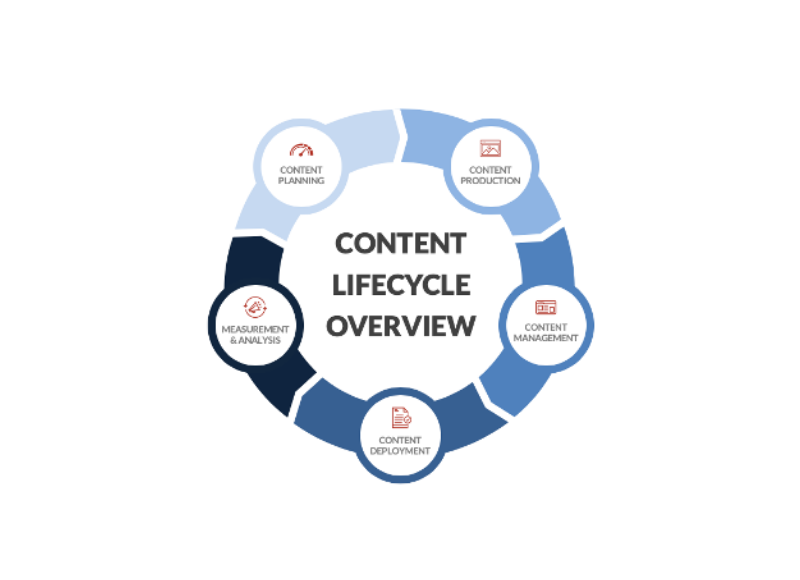Strategy
Apr 22, 2020
Intelligent Content Part 5: How to Optimize Your Content Process

This is the fifth article in a series devoted to taking a closer look at the pillars for intelligent content activation: alignment, intelligence, technology, and process. This article will discuss the process pillar, exploring common challenges and potential opportunities throughout the content lifecycle.
In the previous articles of this intelligent content series, we discussed approaches to aligning on a shared vision, structuring content for maximum agility and reuse, and integrating technology to activate your content. Your organization can have the right vision, systems, and perfectly structured content, but without the right processes, intelligent content at scale will remain difficult.
In this article, we will walk through how Credera thinks through the content lifecycle to discuss the processes and communication required to effectively create and manage content at scale.
What is the Content Lifecycle?
The content lifecycle provided a comprehensive approach to evaluating and structuring content processes. The lifecycle steps, as shown below, include planning, producing, managing, deploying, and measuring. We cover each step’s goals and challenges in the following sections to equip you to assess and optimize your content process.

Content Planning
Producing and delivering intelligent content starts with a well-crafted plan that aligns content objectives and schedules across the organization. Planning across organizational teams is critical for creating a unified brand voice and message. Without transparency and alignment at the onset of the content creation process, organizations can easily end up with scattered or duplicative branding that lacks purpose and focus.
Analyzing the content planning phase will ensure content created for each channel fits into the execution of a cohesive content strategy. Consider the questions below as you begin analyzing and optimizing your content planning process:
Who owns the marketing calendar?
How do you decide what gets put on the marketing calendar?
How is the marketing calendar shared and reinforced within the organization?
How often is planning done? Does the process follow agile methodology?
Content Production
Content production includes the actual creation of content throughout the organization or through agencies. Among the many complexities and challenges that organizations face when producing content, lack of clear and efficient communication often surfaces as a common underlying issue. Communication gaps and role misalignment within an organization’s content creation process can create large inefficiencies and duplicative work for departments. Communication plays a crucial role in ensuring the planned creative voice and style actually reaches customers.
So how do you begin communicating effectively? Start by clearly documenting content production processes and defining owners to ensure content aligns with the overarching strategy. Understand hand-offs in the process and provide a shared digital asset repository to allow for easy access by all teams. Aligning content creation with the overall content strategy and sharing digital assets will create a consistent user experience and brand voice, regardless of who is producing the content. Ask the following questions about your organization’s content production activities to begin streamlining the process:
What is the process for creating each type of content, and what teams are involved?
Who are the owners, content creators, reviewers, and approvers within each process? How long does content approval take?
Where are assets stored so they can be leveraged by your ecosystem?
Does the content abide by a design system or brand strategy? How is this enforced?
Content Management
The next phase in the content lifecycle is content management, or the process of gathering, publishing, and maintaining content. While content management can be a challenge for organizations of any size, it becomes increasingly complex with emerging channels and translation requirements. Multi-national organizations may find themselves spending valuable time creating and organizing manual permutations of content for various channels and locales.
A holistic evaluation of your organization’s content management should include a thorough assessment of the people, processes, and tools involved in transforming, maintaining, and archiving content. Leveraging the right tools allows for content reuse and agility and cuts down on manual transformations. Ultimately, a content management system (CMS) that is effectively managed can enable your organization to harness the benefits of intelligent content. See part four of this series for more information on types and functions of a CMS. Below are a few questions to help you begin analyzing your content management process to identify opportunities for increased efficiency:
Do you create unique content per channel or is content shared across channels?
How is information organized and managed within your CMS?
What content is translated and what is the process for managing translations?
Do you have a well-defined content taxonomy and tagging structure? And is it adhered to by all content creators?
Content Deployment
Content deployment involves publishing content to be made visible to consumers. Combined with an effective content plan and content production process, content deployment is the last step to make sure consumers can see your strategic content. Effective content deployment ensures published content is efficiently shared through the right channels at the right time. Automation capabilities can be considered as a way to improve the content deployment process by lightening the load of tedious publishing processes that are prone to error.
Quality standards must continue to be upheld until the content has been deployed. Consider not only accuracy and compliance with relevant regulations, but also your content strategy and desired brand voice to ensure the deployment process is enabling your content to make the desired impact on consumers. Ask yourself the following questions to analyze the effectiveness your content deployment procedures:
What is the end-to-end process for publishing content? Is the process documented and consistent throughout the organization?
Who has final approval of the content that has been created?
Is content deployment automated/repeatable or manual and tedious?
Measurement and Analysis
Measurement and analysis are the last pieces of the content lifecycle puzzle, and they are invaluable in making data-driven decisions and quantifying the return on content investments. We understand that tracking content ROI is often an ambiguous and tedious process, and it can be an uphill battle to define measurable KPIs and set up the systems required to track success.
When approaching an initial definition of KPIs, it’s tempting to want to track and analyze as many metrics and as much data as possible. While volume of data can be powerful, a focused approach to measurement and analysis will provide you with the most valuable insights that lead to action. Return to your content strategy and business objectives and consider the metrics that will indicate success. After defining these KPIs, be forward-thinking and create a plan for how you will use your data to inform future decisions. Consider these questions when beginning to assess your content analytics approach:
What metrics are important to track in regard to content performance? Which of those do you currently track?
Who reviews, analyzes, and makes decisions based on customer analytics? How often is content being analyzed for effectiveness?
What tools, if any, do you use to measure the return on content investments?
Process Without Practice Is Pointless
The key to activating effective content processes throughout an organization is education and training. Even the best strategy can fall flat if the people involved are not aligned on the purpose and well trained to perform their roles. For more on the importance of managing an organization-wide change, see Managing Change Means Managing People.
Optimizing Your Content Lifecycle
Analyzing and optimizing your content process can seem overwhelming, but we hope the content and questions above provide a kickstart to assessing your organization and identifying areas of opportunity. For more information or to discuss how your organization can activate intelligent content, please reach out to us at marketing@credera.com.
Contact Us
Ready to achieve your vision? We're here to help.
We'd love to start a conversation. Fill out the form and we'll connect you with the right person.
Searching for a new career?
View job openings



